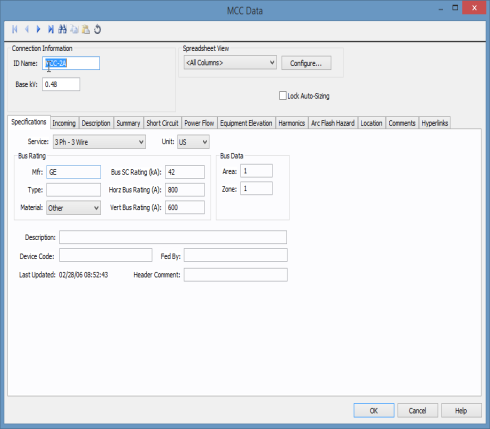
This dialog box includes the following areas and tabs:

Figure 1: MCC Data Dialog Box
ID Name: Uniquely identifies the MCC. This ID name is sometimes referred to as the MCC name, and can be up to 12 characters long. The names default to MCC-1, MCC-2, MCC-3, and so on as you enter new MCCs on the one-line diagram, but you can change those names later if needed.
Base kV: The base kV of the MCC. MCC’s are modeled like a bus in many ways. You can connect cables, busways or transformers to it, and perform fault calculations.
Spreadsheet View and Configure: See Spreadsheet View for information about these options.
Lock Auto-Sizing: When this check box is selected, the MCC cannot be auto-sized.
These are the specifications for the MCC including the bus.
Service: Select the service for the MCC. Your options are 3Phase-3Wire or 3Phase-4Wire.
Unit: Select either U.S. or Metric.
These are all user-defined fields.
Mfr: Use this text field to describe the MCC manufacturer.
Type: Use this text field to further describe the MCC manufacturer model.
Bus SC Rating (kA): The rating of the bus used in calculating the Short Circuit duties for SmartDuty™.
Horz Bus Rating (A): The current rating of the horizontal bus.
Vert Bus Rating (A): The current rating of the vertical bus.
Area: Area numbers are used to uniquely define different areas of the electrical system. These areas can then be used for creating specific text reports from analysis operations that represent subsets of the system. For example, typical paper plant areas may be the power house (Area 1), caustic plant (Area 2), pulp mill (Area 3), and paper machine (Area 4). Area numbers are positive integers between 1 and 999.
Zone: A zone number is a sub-area. This allows even more specific reporting. You might want to define the pulp mill as Area 3 and the digester electrical equipment as Zone 2. Specific reports can then be generated for this combination without including the entire pulp mill or the other digesters.
Description: Use this text field to describe the particular MCC.
Device Code: You can type letters or numbers to describe the device code for the MCC. The information can be converted and printed as a QR code on arc flash labels.
Fed By: Use this field to indicate the transformer or the power supply source feeding the MCC.
Last Updated: The date and time the MCC data was last updated is displayed here.
Header Comment: Use this field for any comment on the MCC.
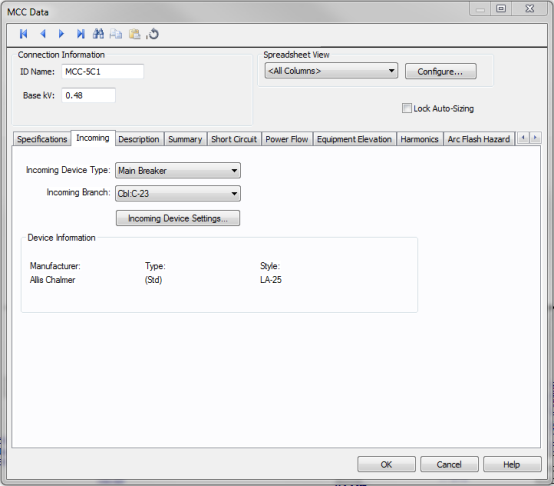
Incoming Device Type: You can select the type of incoming protective device type for the MCC. The choices available are:
Incoming Branch: Select the incoming branch equipment such as cables, transformers or busways. All the branches connected to the MCC in the one-line are displayed.
Incoming Device Settings: Opens the data dialog for the main fuse or main breaker specified as the incoming device type. See Low Voltage Breaker Data or Fused Switch Data for more information.
This is a spreadsheet listing similar to the Device Library. When you place a new MCC on the one-line, the first time you open its database dialog and click on the Description tab, EasyPower displays the MCC Spreadsheet Creation Wizard which enables you to select the number of rows you want. Clear the check box at the bottom of the Wizard dialog if you don't want it to appear with each new MCC. You can insert or append new rows in the spreadsheet should you need them later.

Figure 2: Description Tab of MCC Data Dialog Box
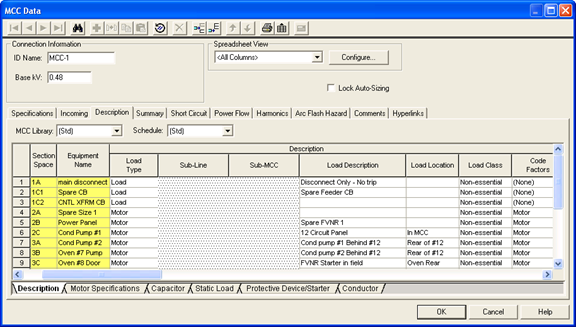
Figure 3: MCC Spreadsheet Creation Wizard Dialog Box
When you click on the Description tab, additional buttons become available on the MCC Data dialog box toolbar. Some of these buttons are the same as those in the Device Library (see EasyPower Device Library) and they offer another way to add rows if the Wizard is not used.
MCC Library: The list contains all of the same schedules as the Device Library. To enter a listing other than those contained in the list, create a new page in the MCC section of the Device Library. See EasyPower Device Library for more information.
Schedule: This list enables you to specify which Device Library Schedule your chosen Library Load spreadsheet is located in. To enter a listing other than those contained in the list, create a new page in the MCC section of the Device Library. See EasyPower Device Library for more information.
Export: The spreadsheets can be exported to metafiles (.WMF) or delimited database text files (.CSV).  Export is beside the Print button on the MCC/Panel dialog box toolbar when the viewing the Description tab.
Export is beside the Print button on the MCC/Panel dialog box toolbar when the viewing the Description tab.
Note: The Section Space and Equipment Name are not necessary for calculation purposes but are used to match the way they are organized in the MCC.
Section Space: Enter the location of the individual bucket in the MCC. Typical entries would be 1A, 1B, 2A, 2B, 2C, and so on.
Equipment Name: Enables you to identify each piece of equipment.
Library Load: This list corresponds directly to the Library Load column in the Device Library. After you have made selections in the MCC Library, Schedule and Library Load fields, all of the data cells that follow are automatically filled in when you click on another cell. You can also double-click on the cell to enter something different than what is listed.
Status: The third column is a toggle "On/Off" to indicate if this particular item is currently connected to the MCC schedule. This affects the power flow and short circuit current contribution.
Load Type: You can select different kinds of loads such as motors, loads, or sub-MCC/panel. Based on the load type selected, various analysis are possible. When you select a load type, the cells in the row that do not apply become unavailable. You might see a Data button indicating you need to enter data specific to the load type. Cells highlighted in red require data in order to perform any analysis. The following load types are available:
The rest of the fields correspond directly to those in the Device Library. MCCs are validated upon creation. That means that if you create an MCC and do not input any data, you can still go into an analysis focus without receiving an error message. However, after you create a row in this spreadsheet, you will not be able to enter an analysis focus until all required data is input. The cells which require data for analysis are highlighted in red.
If you are making a custom entry, you will notice that many of the data cells contain lists of items. Some of the cells have Bold headings, and when they are selected the Calculate button becomes active. Clicking it calculates the data for those cells. You can select several cells at a time before clicking Calculate. For instance, clicking on the header itself will select the entire column.
Because the MCC is a library, along with the Calculate button, all of the other editing features are identical to those listed in the customizing section for the Device Library. See Customizing the Library for more information.
Use Spreadsheet View to configure the columns that appear in the spreadsheet. You can create new configurations that display only selected columns. To create a new configuration, click Configure. In the Database Print Config dialog box, type the new configuration name in the Configuration field, and select the desired column headings in the Columns pane.
Use the Select All check box to include all the columns, or Clear All to clear all columns and select only those you want to see.
Use Delete to remove the selected configuration.
Close saves your changes and closes the dialog box.
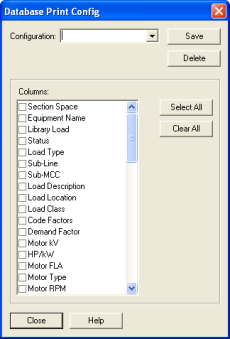
Figure 4: Database Print Config Dialog Box
If you have multiple configurations saved, you can display the desired configuration by selecting it in the dialog box.
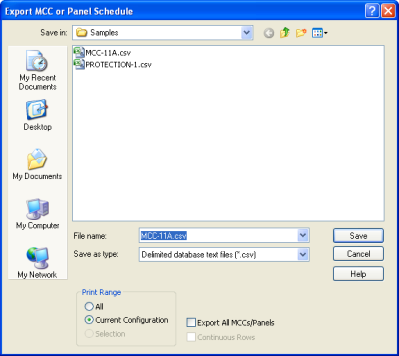
Figure 5: Export dialog for MCC or Panel Schedule
Save as type: You can save the schedule as a CSV (spreadsheet) file or as a WMF (picture) file.
Print Range: Choose one of the following.
Export All MCCs/Panels: When clear, only this MCC or panel is exported. When selected, all the MCC and Panels are exported.
The Summary tab of MCC Data dialog box provides the total load on the MCC and the load that must be used in designing.
Calculate Downstream Load: Calculates the total load on the MCC, taking into account the connected load, demand factors, diversity factors and NEC code factors.
Override with User Values: This check box enables you to enter data in the Total Downstream Load – kVA column.
The spreadsheet has two sections – MCC Load and Including Downstream Load.
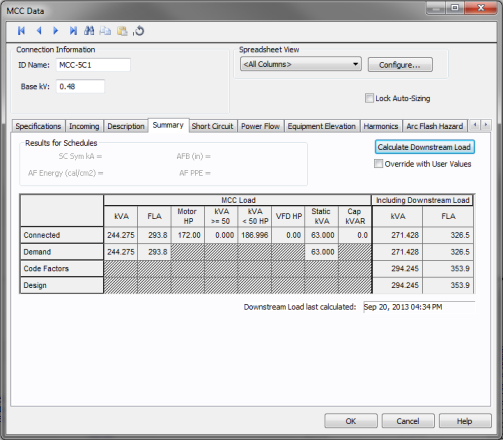
Figure 6: Summary tab of MCC Data Dialog Box
This spreadsheet section provides the summary of the loads fed by the feeders of the MCC. The loads from the sub-MCC and sub-panels are not included in this section.
Total kVA: This is the aggregate load.
Total FLA: Total load in amps.
Motor HP: The total HP for the items with "On" in the Status column of the Description section.
Motor kVA >= 50 HP: The total KVA for connected items equal to or greater than 50HP.
Motor kVA < 50 HP: The total KVA for connected items less than 50HP.
Static kVA: Total kVA of the loads.
Capacitor kVAR: Total kVARs of all the capacitors.
Information about the calculations are provided below:
Connected kVA = [(SkW)2 + (SkVAR)2]1/2
Demand kVA = [S(kW * DF)2 + S(kVAR * DF)2] ½
Where DF is the individual demand factor of each MCC circuit.
Code Factors kVA = [(kWL + SkW)2 + (kVARL + SkVAR)2]1/2
Where, kWL = Code Mult Factor * kW for largest motor in MCC.
KVARL = Code Mult Factor * kVAR for largest motor in MCC.
kW and kVAR are for the rest of the loads.
The code multiplying factor is specified in Tools > Options > Equipment.
Design kVA = Code Factors kVA * Diversity Factor * Design Factor
Diversity Factor is specified in the Specifications tab of MCC Data. The Design Factor is specified in Tools > Options > Equipment.
This provides the sum of the loads fed by feeders inside the MCC and the sub-MCC and sub-panels.
kVA: Total kVA load calculated. You can enter your own values in these fields by selecting the check box for Override with User Values.
FLA: Total FLA load calculated. You can enter your own values in these fields by selecting the check box for Override with User Values.
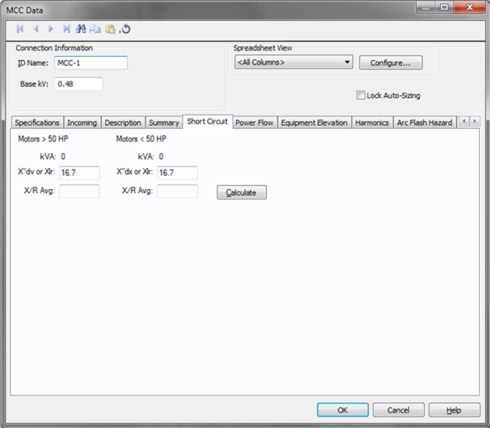
Figure 7: Short Circuit Tab of MCC Data Dialog Box
kVA >50Hp: Total kVA of the motors which are greater than 50Hp.
X"dv or Xlr: Is set at the default value for >50Hp. You can enter your own value and it applies to all the motors greater than 50Hp.
X/R Avg: Calculate fills this field using values from the spreadsheet. You can enter your own X/R Average.
KVA <50Hp: Total kVA of the motors which are less than 50Hp.
X"dx or Xlr: Is set at the default value for <50Hp but you can change this. You can enter your own value and it applies to all the motors less than 50Hp.
X/R Avg: Calculate fills this field using values from the spreadsheet. You may enter your own X/R Average.
Calculate: Click to calculate the X/R averages for motors greater than and less than 50 HP.
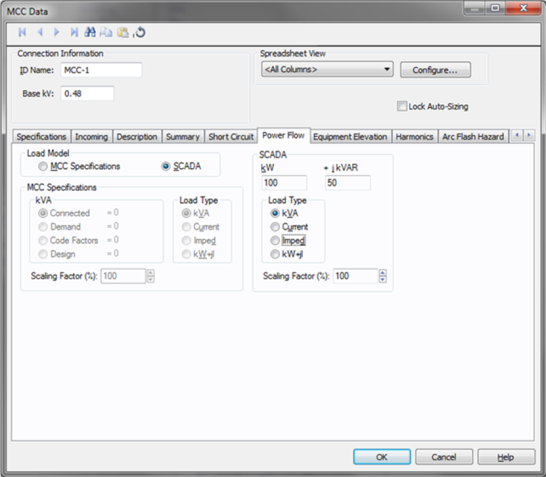
Figure 8: Power Flow Tab of MCC Data Dialog Box
Load Model: Enables you to select the motor kVA from the MCC Specifications data or from SCADA (Supervisory Control and Data Acquisition) data. SCADA data can be read in by clicking the  EasyPower button and then clicking Import (toolbar menu: File > Import).
EasyPower button and then clicking Import (toolbar menu: File > Import).
kVA: Select the method used to determine the kilovolt-ampere for power flow analysis. Choose between:
Load Type: Motors can be modeled for the power flow solution in several different ways.
Scaling Factor: Provides an easy way of adjusting the total motor load used in determining power flows. By changing the scaling factor, the actual Hp (total connected value) entered in the Hp field can remain static. This reduces modeling errors and eliminates multiple databases for different contingencies.
SCADA data is derived from real time, or metered data, and converted to an ASCII format which can be read into EasyPower. SCADA data is read in as a 100% scaling factor load. The load value is multiplied by the user-defined scaling factor. This provides a way to adjust SCADA loads to form new cases.
kW: The kW value as read in from the SCADA ASCII file.
kVAR: The kVAR value as read in from the SCADA ASCII file.
Load Type: SCADA data can be modeled in the power flow solution in several different ways. SCADA load type is set in the ASCII file, but can be changed by you.
Scaling Factor: Provides an easy way of adjusting the total SCADA load used in determining power flows. By changing the scaling factor, the actual kW +j kVAR read in from the ASCII file remains static, however the load used in the power flow is adjusted by this factor.
See MCC Elevation for information about this tab.
Use the Harmonics tab to indicate whether this equipment item is introducing harmonics into your power system.
The default is Linear, indicating the equipment does not produce harmonics. Choosing Harmonic makes the item an harmonic source and makes other fields in this tab available to edit.
Note:
For an adjustable frequency drive (AFD), the Load Type is always Harmonic.
For motors, the Load Type is Harmonic if the With Adjustable Frequency Drive (AFD) check box is selected on the Specifications tab of the motor; otherwise, it is always Linear.
Use the spreadsheet to enter the harmonic spectrum produced by this item. You can enter up to 30 different harmonics in each equipment item. In the spreadsheet, enter the Harmonic Number (such as 5 for the 5th harmonic), the Harmonic Current in percent of the Fundamental Amps, and the Current Angle. By indicating the current angle, you can simulate transformer phase shift effects on rectifiers so appropriate canceling can take place. The harmonic may be integer or non-integer.
Common harmonic spectra may be entered from the device library. For instructions on how to enter your own spectra information, see Harmonics with Spectrum™. After selecting a particular device library spectrum from the Mfr and Type lists, click Import, and that spectrum is entered into the harmonic spreadsheet.
EasyPower offers two methods for calculating RH:
RH = RFund * H R-EXP
RH = RFund * (1+ECF*H2)/(1+ECF)
EasyPower defaults all skin effect correction to R-EXP and a value of 0.5.
| R-EXP | %ECF | |
|---|---|---|
|
Transformer |
0.5-1.0 |
1.0-3.0 |
|
Utility |
0.0-0.8 |
- |
|
Generator |
0.3-0.6 |
- |
|
Line/Cable |
0.5 |
- |
|
Reactor |
0.5-1.0 |
0.8-3.0 |
|
Motor |
0.2-0.4 |
- |
Use to set the fundamental amps. The options are as follows:
To use fundamental current calculated by power flow, select Calculated from Power Flow in the Summation Fundamental Voltage area of the Harmonics Options > Control dialog box.
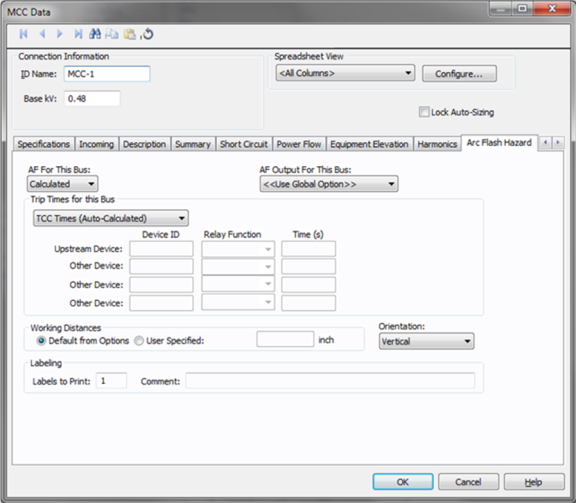
Figure 9: Arc Flash Hazard tab of MCC Data
Since the MCC can be analyzed like a bus, you can also obtain arc flash hazard assessment results for MCC. The arc flash tab is similar to that of bus data. However, the equipment type is forced to MCC/Panel, since an MCC cannot be another type. You can specify the trip time as available in the default library, enter the incident energy or you can enter the trip times in the fields. For detailed descriptions see Arc Flash Hazard.

Figure 10: Location Tab
You can specify the location of the equipment on the floor of a building. You can give the location a name, specify the X and Y coordinates of the location, and select a floor.
The coordinates could be measured in feet, for example, or they could represent points on a grid. There are no units associated with the coordinates, so you can use whatever measurement makes sense for you.
Facility: The building in which the equipment is located. Facilities are set up under the Tools > Options arrow under Facilities.
Location: The location of the equipment. This is the combination of the Ref 1 and Ref 2 boxes set up on the location. Locations are set up under the Tools > Options arrow under Locations.
Description: This is a description of the location. The default description comes from the location, but you can change it. You can type up to 32 characters.
X: This is a numeric value (such as feet or grid locations) that represents the horizontal location. The default X value comes from the location, but you can change it.
Y: This is a numeric value (such as feet or grid locations) that represents the vertical location. The default Y value comes from the location, but you can change it.
Floor: Select the floor where the equipment is located. Floors are set up under the Tools > Options arrow under Floors.
For more information, see Facilities, Floors, and Locations.
This tab is read-only and appears only if you have imported data from an SKM Data Format file. See Importing an SKM Format File for more information.
See Comments for information.
See Hyperlinks for information.
| Database Technical Reference |